As I pulled the mohair saddle cinch tight on the paint mare, Roxy, I had time to finally consider what I was doing, and wonder if it was a good idea. Roxy could be a little out of sorts on occasion and has introduced several riders to the unexpected sensation of flying. Although she occasionally bucked off a seasoned veteran, it was the inexperienced riders that were the most common victims.
I could usually see it coming from a distance. Rider would relentlessly pull on Roxy’s bit giving her constant irritating pressure, but no release. She was like a pot of potatoes on the back burner. Before you can get there, those taters erupt into a lid-unseating boil. Roxy eventually just had enough of the pain of the bit sawing on her mouth and finally boiled over.
I vividly remembered the last time I saw her buck. I had roped a calf from George’s back, dallied the rope around my saddle horn, and tried to follow the calf around the corral to keep rope tension off him. The little steer needed eartags, and I wanted to give him a look-over, but he flat tore off when the rope caught him. The problem was that he ran around Jeremiah aboard Roxy, and as the nylon line between us went tight, it lodged solidly under the paint’s tail. I tried to follow with free rope up by pulling my dally, but it was too late.
It was all it took. The potato pot boiled. Hard. Strong-as-an-ox Jeremiah held on, even though Roxy gave it all she had. He rode her out, and she finally calmed down, but she had bucked enough to send Jeremiah’s treasured Old-Timer knife into orbit.
I found it a year later on the other side of the corral about 75 feet away.
Then there was George. He had a little of the same thing going on. Just last fall I had a green rider screaming in terror on him because he wouldn’t respond to incessant pulling on the reins with a stop. “We have a runaway!” the other riders yelled. I stepped my Ginger mare in front of him to head him off and he slid to a stop in the mud of the rain soaked trail.
Dang.
Then Ethan related how just last week he watched new cowboy Anthony’s straw hat bobbing up and down like a butter churn just behind a little rise. It took Ethan a bit to realize that the bobbing hat was still on Anthony’s head, and it was bobbing because George underneath him was bucking and trying to unseat him.
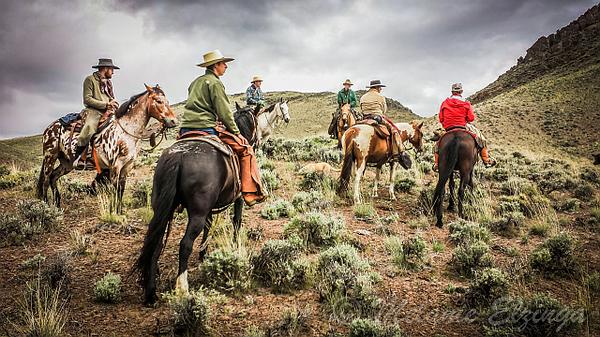
they had reached a mutual understanding.
As I thought on these things, I finished securing the tack and climbed on Roxy’s back. Meanwhile, Linnaea finished George’s saddle and stepped on. We brought them into a smooth trot, going through the motions of warm up and watching for any rank behavior.
They seemed fairly collected.
Now I had to work on my riders. I needed John and Lisa to return from our ride in one piece to John’s five year old and delightfully precocious daughter who would stay in camp with Linnaea. I was glad Linnaea was snake wise for the kid’s sake. Rattlesnakes liked the shade around camp, and there was a nice snake den just up the hill in some rocks above camp. Just that morning I had stepped over a busily rattling one as I “visited some tall sagebrush” just outside of the view of camp.
As I eyed my riders, John and Lisa, I wished again that we had some horses that anybody could ride. You know—well broke, quiet, older and gentle. We have 21 horses. The geriatric ones are in well-deserved retirement at home on green grass, occasionally ridden by one of our youngest daughters. The rest of our horses are pretty young, and a still a little green. The fact was that the range horses did better to be a little cantankerous. Their grittiness could carry us through a 35 mile day, and get us back to cow camp. But the flip side was they were not very gracious with inexperienced riders that pull on their bits all day.
John was raised around horses, but it had been awhile. Now, a real estate broker in Boise, he had just finished a career playing professional rugby, so was quite athletic, coordinated, and solidly built. I handed the reins of the paint horse Roxy to him. Lisa, his girlfriend, was also athletic and in very good shape after working hard in post back surgery therapy. She had been on a horse once in her life for a total of a few hours just several weeks earlier, exploring of all things Iceland’s tundra on an Icelandic pony. She was to ride George, and was a little dubious looking as she stepped on board.
 “‹”‹”‹”‹”‹
“‹”‹”‹”‹”‹
I gave a short reining discussion, and showed them how to use their legs. After one more check of their cinches, I swung a leg over Ginger, and we were off. The problem was that Roxy and George knew the country and wanted to get going right away. They were used to a brisk trot to get somewhere where the work was. George wasted no time with Lisa, and moved into an easy trot. Lisa, unknowing on the ways of trot, felt completely out of control and started to apply brakes. With the continual pressure on his bit, George was escalating. I duly noted the signs. I loped to the front of him and cut him off on the narrow trail. Lisa looked a little flustered. This could be a long day”¦or a very short one.
I checked on John. Thankfully, he had a pretty good seat on a horse and looked pretty secure. We trotted again, because John just let Roxy take off. John was living in the moment, reliving his childhood, and his lady slipped to the backburner for just that short time. Lisa looked at me imploringly. She knew her butt and recent back surgery couldn’t go on getting beat up like this all day. Meanwhile, John continued living his equine dream. He said something about Clint Eastwood last night around the campfire, and perhaps Pale Rider was now the Paint Rider. We all have our own version of reality, after all. He was living his.
Lisa needed to post. Posting is a way of pumping your own torso to match the horse’s rhythm during the trot—the roughest gait of the four gaits of horses. English riders do it as a rule and we western riders use it too, although with a little less polish. It’s just easier on the horse and rider. I gave her a quick lesson and she was a quick study, displaying palpable relief as she fell into the rhythm of George’s trot. Her hands released a death grip on saddle horn and reins and relaxed as horse and rider melded and joined as a team.
I relaxed too. This was going to be OK.
We climbed out of the willow thickened and boggy creek bottom and turned our way up to the drier hills. John had heard me speak at various venues in Boise over the years about our beeve’s harvest of wild Idaho ranges, and wanted to visit our operation firsthand. Although John was interested in the how’s and why’s of our operation, unbeknownst to me there were other motivations for him to ride with Lisa across this big sky country.
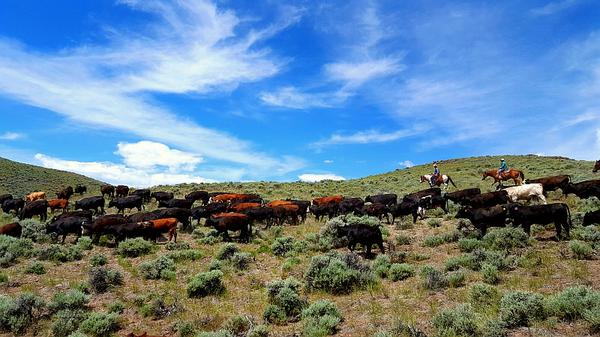
The grass is lovely this year from the frequent spring rains and snows that punctuated sunny days over the past month. As we climbed steadily to the high tablelands, we rode through gravely hills of volcanic remnants now cloaked with wildflowers and green grasses, waving in the mountain breeze. Frequent blazes of Indian paintbrush lit the hillside with vibrant reds and pinks and clumps of brilliant yellow Enceliopsis and white arenaria randomly flashed in the sea of green.
John sat resting aboard Roxy with her fluttering mane and tail on a windswept ridge as Lisa and I rode up. “This reminds me of the South African Veldt. These high green tablelands, with the breaks and vertical cliffs that plunge to the Salmon River”¦this is just incredible country.” John’s international rugby career had taken him to far flung corners of the globe, but his humble upbringing in Jerome, Idaho as a son of an onion farmer are what I think honed his observational skills at reading a landscape.
We stood for a bit as big cloud shadows pitched and rolled over the deeply corrugated landscape. I scanned the rippled horizon for cattle and Clint and Leslie who shepherded them. No sign yet. I had a chance to visit with Clint in the predawn early light as thick slabs of bacon graced the cast iron pan on the cook stove and wild elk climbed the hillside behind camp, and talk about how the grazing was going as we drank thick coffee. They had left cow camp with the cattle soon after the sun broke the horizon, a few hours ahead of us.
This was Clint and Leslie’s 4 day stint. Mine was last week, so we were only visitors, and they had a vision and plan for where they would find pristine meals for their 250 black Angus charges. Since I come up with the grazing plan overview the week before, I knew where they should be. We had a little ways to go to hit the high ridge where I expected to find them.
As we descended over the rocky rim of Precambrian schist into the next canyon, I led our little group and let Ginger pick her way through the rocks. A big coyote emerged and ran silently ahead of us as we clattered through the boulder field. He stopped to check out his visitors frequently as he disappeared into the canyon. Lisa, bringing up the rear, called out to me in a voice that betrayed the lack of concern on her demeanor. “What do I gotta do to keep him from just running down through these rocks?”
I turned and scoped out the situation. “Just have George follow Roxy. He’ll mind and pick his way like he’s supposed to.”
And so he did. As we rattled our way to the canyon bottom, we cut some yearling tracks and an occasional horseshoe print in the ash. “They’ve been here. They must be just ahead of us.” I cocked an ear as I heard the faint but reverberating cowherding call of Clint echo across the hills. Soon enough, I caught the silhouette of cowpoke Clint on the horizon far above us, bringing up the drag, or the rear of the cattle train that grazed the ridgetop.
“‹”‹”‹”‹”‹”‹”‹
We launched into a long trot to catch up to the herd. When we finally arrived there, Clint and Leslie had them settled for a break on a windswept and rocky bald. There would be no bugs up there, and the beeves laid down comfortably in the balmy sun among the grasses.
Trudy, or “TrueDog” as we often call her, is more interested in the cattle just off to the right, than the stunning display of Indian paintbrush at her nose.
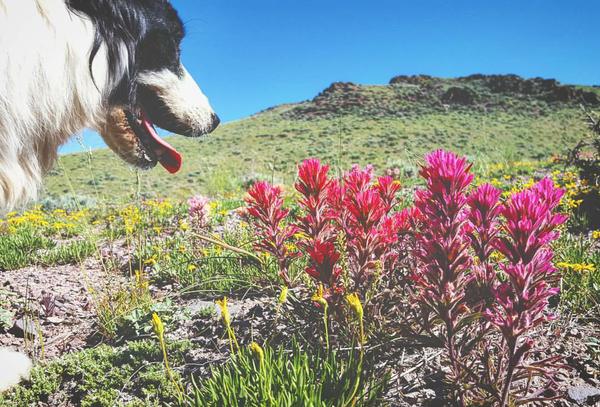
We foraged a little raw bitterroot from the volcanic substrate and pulled some jerky from saddlebags, and bantered with Clint and Leslie as we shared victuals. Clint and I shared the language of herding and horse as we spoke about finding the best meal for the beeves. We share a passion for stockmanship, and enjoy swapping ideas on the art of directing cattle across country, and placing them on the best grazing wild landscapes offered.
Stockmanship on these wild landscapes means balancing plant ecology, animal and human safety, and developing in the herd a confidence that you are trustworthy as a shepherd (preventing stress of any kind), and keeping them hydrated strategically so that you can cover the most country between water without them getting thirsty. There’s so much to it, and I think Clint and I would both agree, despite doing it for some years that we still have much to learn.
After a short siesta, we helped Clint get the cattle on the move to new grass on the high ridge above us. I placed John and Lisa on the right flank above us, so they wouldn’t interfere with Clint and Leslie’s establishment of movement and direction of the herd. It’s kind of an unspoken respect we have for each other; if it is your herd that day, then visitors take a subordinate role.
As the beeves lined out across the slope, I saw that John and Lisa fell behind and brought up the drag. They just bumped tail-enders along and kept them with the bunch. Perfect. I didn’t know if it was their take on the deal, or Roxy and George’s. After all, those two equines have done this same gig for 3 years.
It turns out it was a mix of both.
As the bunch made its way across some of the best grass I was seeing this year, I realized I hadn’t seen much of John and Lisa for the past hour. Clint, Leslie and I were still working the front of the herd, training them to slow down and taste the roses instead of just walking. Usually it takes a month or so to get them to slow up and graze. Training periods like this slowly shifts the animals from an instinctive flight to a trust in their herders. It was the first time many of these steers had seen big fenceless country, and their initial tendency was to find the end of it. The problem was that sometimes the end was 10 miles away in a cliff, canyon or our grazing country boundary fence, and they would forget to eat on the way.
I worked my way around the bunch over the rise that the herd straddled to see if I could glimpse John and Lisa. I was a little worried that something went wrong: “You know Glenn, you are the worst guide and host that I have ever seen. This horse has been freaking out on me, and I broke my arm when I got bucked off. Where the blank have you been?” My mind could go wild sometimes.
But as I broke the ridge, all seemed well. There they were, minding the drag, pretty close together. Their horses were calm. As I rode up to John, he had a slightly whimsical, happy aura about him. “You know, it is just beautiful up here. You’ve got a great life, Glenn. I’ve been thinking about so many things—big picture things while I’ve been up here. You have no idea how much Lisa and I needed this.”
I smiled. And really, I knew he was right. Sure, in the heat of the moment, we take things for granted. But the big open country does grab you”¦and change you in life’s perspective.
John went on: “So, I just figured it isn’t going to get any better than this. I rode up to Lisa, and said ‘Hey, Lisa, your cinch is getting loose. Let me check it out for you.’ I got off Roxy and walked over to her while she sat on George. Then I reached down into the dirt by George’s foot and said, ‘Well look what we got here.'”
I looked at him quizzically.
He smiled. “I showed her what I had found. It was old mine cut diamond ring I’ve been saving for this moment.” He caught my eye. “I asked her to marry me.”
“What? Are you serious?” I could tell he was. “Did she say yes?”
“She did.” His grin was contagious.
I looked over at Lisa, now 50 yards downhill. “Show me your hand!” She looked up, lifted her hand high, back of it toward me, and fairly beamed. I caught a glint of diamond shine in the high altitude sun.
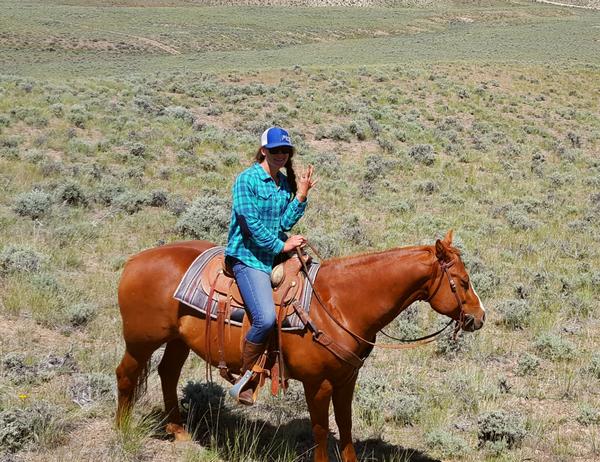
“‹”‹”‹”‹”‹I reached out my hand to John and shook his across the space between our horses.
“How long have you been waiting for the right moment?”
“Four weeks. Like I said–It wasn’t going to get any better than this.” He gestured across the expansive view below us.
“You didn’t even have to kneel!” He just looked up to her on George. “Congratulations!”
As I turned my mare back to the beeves to leave the lovebirds at the drag, I reflected on the fact that John was right. We have a great life here. Sure, the hours are incredibly long, the money is sometimes tight, and our survival and success can be clipped short by storm or drought. Those things can weigh heavy and occasionally rob sleep, but I wouldn’t trade our existence for anyone’s.
Caryl and I reflected more on these thoughts as our visitors headed back to Boise. It seems everyone who has come to Alderspring, even for an hour or as long as a summer cowhand position leaves changed. We try to put our finger on what it is, but it isn’t just one thing. Maybe it’s the feel, the landscape and the wildness of the country on which we work. I think they get a taste of having to survive by wit and resolve. There are no options other than that, and it arouses in us a primal instinct that feels right. I don’t know.
Maybe it’s more.
Here’s what John thought about it. He shot this email to me just this morning:
“Abundant. It’s the word that comes to my mind as we drove away from Alderspring Ranch. The word tells of more than the aesthetic beauty of this place. It’s the people, the story, the authenticity, the value they deliver. These people are crafting a new way of producing food with a story. They aren’t conserving resources there, it’s beyond that. Resources are being regenerated. Alderspring Ranch is a place like no other.”
I’m hoping I can bring you, dear reader, into that experience by sharing these stories, and maybe you can begin to understand what a wild and pristine landscape your beef is raised in. Thanks for coming with us on this journey where we learn more every year about raising wild protein in the image of nature and ancient traditions. It’s not easy, but it is rewarding. After all, nobody said the buffalo that grazed this country prehistorically had it easy either.
But there are fringe benefits that make it all worth it. Like when John happened to “find” an old mine cut diamond ring in a white gold setting in the volcanic ash. And he even found a finger handy to put it on.
I’m sure glad she said yes.





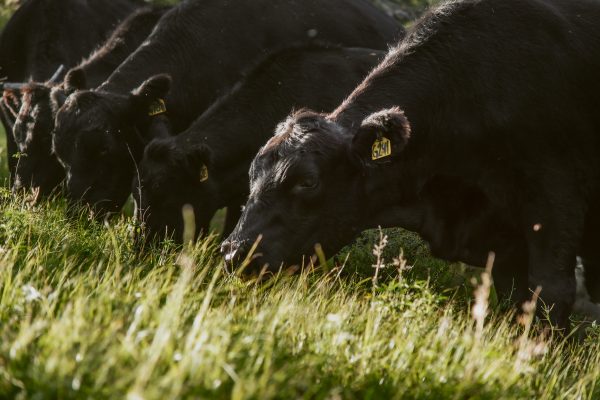
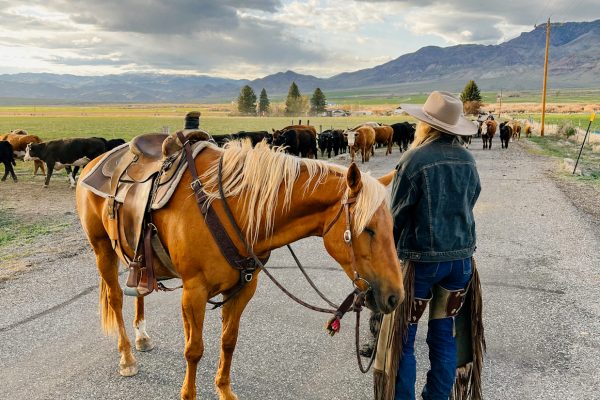
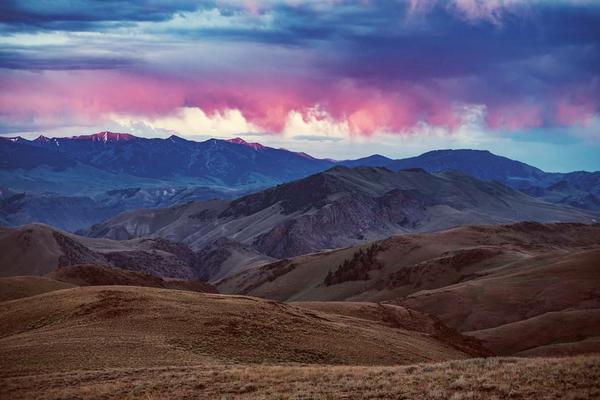
Leave a Reply